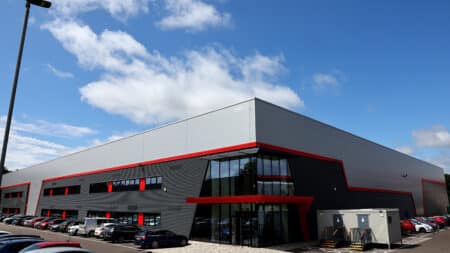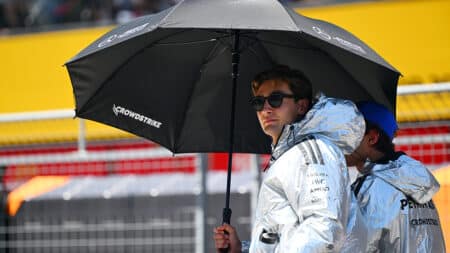
'Not even the best F1 driver in his family' - Pain of being the other Schumacher
He has always been overshadowed by his older brother but Ralf Schumacher’s 50-year story is more layered, and more human, than the stats alone suggest, says Matt Bishop
To buy the lead image click here.
For those fans that feel F1 is too complex, that it has regulated itself up its own slot gap, the new-for-2016 tyre choice is yet-more ammunition. But – as with the change to the qualifying procedure (that now definitely will be in place right from the start of the season) – if you think of it as just back-stage fine-tuning trying to make a better race, you don’t even need to think about it. The cars will still line up in some sort of performance order and set off to race each other and the first past the flag wins, with points down to tenth place.
However, for those who do like to know about what lies beneath and de-constructing the exercise, here’s how the new system works, using the season-opener as a case study.
Pirelli has chosen the compound range for Melbourne as medium (white walls), soft (yellow walls) and super-soft (red walls). Each driver is allocated a total of 13 sets of tyres. Pirelli then stipulates that two of these 13 sets (in this case one set of mediums, one set of softs) must be set aside for the race. Assuming a dry race, one of those two sets must then be used in the race. Use of the other set is not compulsory.
So that now leaves 11 sets from which to choose for the rest of the weekend. Of those 11, one set of the softest compound (in this case the super-soft) must be set aside for Q3. Those who do not make Q3 have that set available for the race. Those who do make Q3 return that set to Pirelli after qualifying.
That now leaves 10 sets from which to choose for the three practices, qualifying and race, spread between the three compounds. In theory you could ask for 10 sets of super-softs and say ‘no thanks’ to any further allocation of the harder tyres. But that would leave you liable to be spending almost as much time in the pits as on track come Sunday, as those tyres quickly wear out.
There is no stipulation that each team must choose the same for both its cars – and the announced choices on Tuesday show variation between the drivers at Mercedes, Sauber and Haas. For Melbourne, the chosen allocation additional to the three sets pre-stipulated by Pirelli is as follows:
| Medium | Soft | Super–soft | |
| Hamilton | 0 | 5 | 5 |
| Rosberg | 1 | 4 | 5 |
| Vettel | 1 | 4 | 5 |
| Raikkonen | 1 | 4 | 5 |
| Bottas | 0 | 4 | 6 |
| Massa | 0 | 4 | 6 |
| Ricciardo | 1 | 3 | 6 |
| Kvyat | 1 | 3 | 6 |
| Magnussen | 0 | 4 | 6 |
| Palmer | 0 | 4 | 6 |
| Hulkenberg | 1 | 4 | 5 |
| Perez | 1 | 4 | 5 |
| Verstappen | 1 | 3 | 6 |
| Sainz | 1 | 3 | 6 |
| Alonso | 0 | 4 | 6 |
| Button | 0 | 4 | 6 |
| Ericsson | 0 | 5 | 5 |
| Nasr | 1 | 4 | 5 |
| Wehrlein | 3 | 3 | 4 |
| Haryanto | 3 | 3 | 4 |
| Grosjean | 0 | 4 | 6 |
| Gutierrez | 1 | 3 | 6 |
* NB. In addition to the above sets, each driver must have 1 set of mediums + 1 set of softs available for the race (only one of which is then compulsory in the race) plus one set of super-softs allocated for Q3 (regardless of whether he gets into Q3).
Essentially the teams will choose tactically, partly based upon their expected level of competitiveness. Mercedes, for example, is much less likely to need super-softs to graduate from Q1 than McLaren and this is reflected in McLaren’s choice of six sets of them to the five of Mercedes. At the other end of the competitive scale, the Manor drivers have chosen four sets of super-softs on the basis that they will probably not be getting out of Q1 – but if they do there are then a further two sets available, either to do two super-soft Q2 runs or – if the super-soft looks a viable race tyre – one for Q2, one for the race. The Friday practices will reveal whether the super-soft or the medium is the better race tyre. Two different compounds still have to be used in a dry race. It can be taken as a given that the soft will be raced by everyone and the choice will therefore be whether to combine it with a super-soft or a medium. Working backwards from there will guide you in how to use the remaining allocation in qualifying.
What defines which is a better race tyre is quite involved and combines peak speed with durability. First of all, is two-stopping faster than one – or three? Because that will define the length of the stints, it can mean for example that the super-soft may be a better race tyre than the medium for, say, a three-stop strategy but much worse if two-stopping. Usually this cannot be called with any confidence coming into the weekend: for one thing there’s still an element of black art about it and for another it’s highly dependent upon the weather and specifically the track temperatures. Practice will help reveal the correct answers – but even then not always, especially if the weather changes. The choices made therefore represent a statistical spreading of the risk coupled with an educated guess about a) the car’s level of single-lap competitiveness and b) how well it treats its tyres.
Red Bull typically keeps its tyres in shape longer than Mercedes and Ferrari – quite possibly because the lower power of its Renault engine is placing less longitudinal stress upon the rears. The McLaren also tends to be good in this respect, quite possibly for similar reasons. It is notable that both teams have gone quite racy in their choices, effectively writing off the medium and nailing their colours to the super-soft mast.
Those teams that have made different allocations between their drivers have probably done so just to cover both basis, allowing for the possibility of conducting back-to-back comparisons in practice to determine the optimum qualifying/race allocation. So we might expect to see in the long runs of Friday Rosberg concentrating on the medium, Hamilton on the soft. Because there are now three compounds to try rather than two, we will also see a different typical running programme this season – and the terms prime and option will become obsolete.
All clear? If so, good. If not, don’t worry about it.

He has always been overshadowed by his older brother but Ralf Schumacher’s 50-year story is more layered, and more human, than the stats alone suggest, says Matt Bishop

Cadillac's Formula 1 entry was approved just 364 days before its first grand prix weekend. We took a look inside its Silverstone base to find out how it's building a brand new team from scratch

Describing this year's championship race as a 'battle' might be slightly over-egging it, writes James Elson

You had to read between the lines at the 2025 Austrian Grand Prix as George Russell dropped hints over about his dissatisfaction, and F1 sent a message to FIA president Mohammed Ben Sulayem